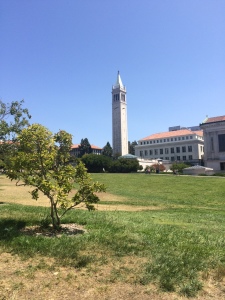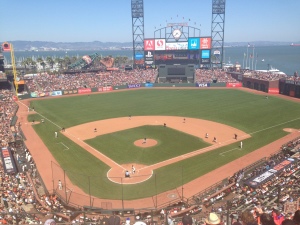Naughty me, I haven’t been keeping up to date with my updates here at all well. This might just signal that I’ve been busy with lots of exciting projects, which is true. However, conferences and holiday also got in the way.

The conference I went to was The Meteoritical Society meeting at the end of July in Berkeley CA. A great location, especially as I had a day free on arrival to explore the surrounding area (and the amazing sports facilities at the University). We also got a day off mid-week to attend a baseball game. I was there with a bunch of mostly clueless Brits from the conference (in the nicest way possible – clueless only in terms of baseball that is – very much not clueless in terms of meteorites) but luckily an American was sat next to me so I had my personal commentator to explain what was going on. And thank goodness, baseball has some important differences to rounders! What I learned here is that the ball is not hit very often but that the whole experience is such a spectacle so its all thoroughly enjoyable anyway – particularly as the game was played at the most gorgeous of locations, the AT&T park in San Francisco. If you get the chance then go! The atmosphere is amazing; a crowd of 46,000 people and it was something like their 138th consecutive sell-out game…it was on a Wednesday afternoon too so I’m not sure how all these people had the day off. Anyway, enough of ball games, the meeting itself was great too.
UC Berkeley is a stunning location for a conference (as you’ll see by the picture above) and with around 400 planetary scientists in attendance, but with only 2 parallel sessions, it made for a more intimate and networking-type meeting than I’m used to at LPSC in Houston. I was chairing the Microsample Analysis session on Friday morning which I also spoke in (and presented a poster for on the Tuesday night). We kicked off with a very interesting talk suggesting that there might not be a continuum of compositions between comets and asteroids. This talk was given by Don Brownlee (of Stardust and IDP fame) and it really made me think about my own samples and the paper I’m currently working on. I actually think I will review my data in light of this. My talk went fairly well – although it’s always hard to tell when you’re speaking because 12 minutes feels like 2 minutes so it’s really hard to assess, but I got some good questions and discussions afterwards. I presented some data on an exciting IDP that I’m working on that has some really strong similarities to very organic rich particles collected as micrometoerites from the ice in Antarctica (and which are thought to be cometary in origin also). I still find it amazing that I get to play with comet dust that’s come all the way from the outer Solar System, and is 4.6 billion years old. It’s well known that we have organic matter in space (just see the Rosetta results, summarised quite nicely in this The Conversation article) but organic matter is often not preserved very well in meteorites because they’ve been through secondary processing in space. Organic matter also doesn’t tend to survive atmospheric entry very well either as it gets heated up and altered there too. So, when we get special comet particles collected from the ice in Antarctica and from the stratospheric dust collections then it makes them very special and I think they are currently a little under-appreciated. I’ll try to change that!

